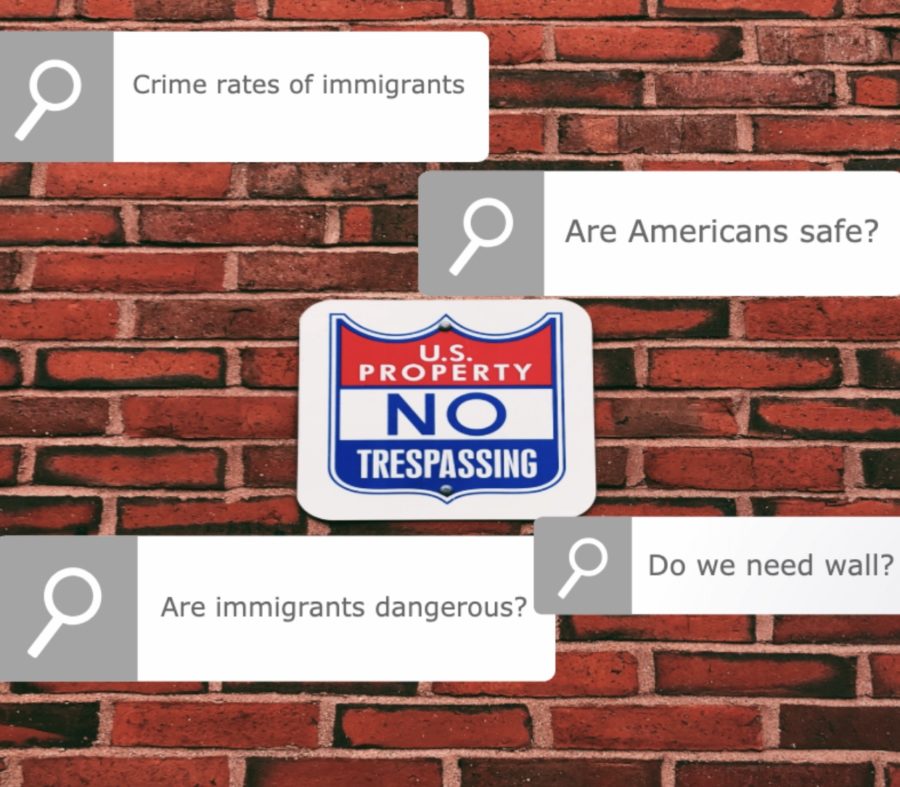Cole Hard Facts: The dangerous immigrant
Editor’s note: The views in the column represent the opinions of its author and not those of Cathedral Catholic High School’s El Cid.
A plethora of questions are asked in regards to the border wall, as many people search for facts and statistics behind the polarizing issue.
February 2, 2019
President Donald Trump executed a partial government shutdown on Dec. 22 due to his desired $5.7 billion for border wall expenses not included in the revised budget passed by the House of Representatives and by the Senate. The shutdown, active for 35 days, was temporarily ended, as the government will reopen for three weeks. The polarizing shutdown led to President Trump giving an address to the nation on Jan. 8.
The address, attempting to spark a sense of danger and concern for the vacancy of a border wall, stirred emotions in both parties. Layered with strategic rhetoric, the interpretation President Trump intended from his speech for his audience seemed obvious: fear an unsecured border.
A variety of issues fuel motivation for the border wall, but according to Oxford Research Encyclopedias, the perceived intense threat posed by undocumented immigrants is the strongest predictor of citizens’ wanting to have strong policy measures to secure the border. This data proves the severity of the misconception that immigrants are more dangerous than the average American citizen.
“In the last two years, ICE officers made 266,000 arrests of aliens with criminal records including those charged or convicted of 100,000 assaults, 30,000 sex crimes, and 4,000 violent killings,” President Trump said in his address to the nation, discussing the partial government shutdown. “Over the years, thousands of Americans have been brutally killed by those who illegally entered our country and thousands more lives will be lost if we don’t act right now.”
The distressing numbers President Trump discusses, however, lead to a harmful and popular misconception that illegal immigrant crime rates significantly surpass the crime rates of native born citizens and that illegal immigrants pose a larger threat than the average citizen. Statistics disagree with this common belief.
The criminal conviction rate in Texas, the home of the second most illegal immigrants in America, per 100,000 residents in 2015 exhibits 1,797 criminal convictions of natives for every 100,000 natives, 899 criminal convictions of illegal immigrants for every 100,000 illegal immigrants, and 611 criminal convictions of legal immigrants for every 100,000 legal immigrants, according to the Cato Institute, a nonpartisan public policy research organization.
In addition to lower crime rates presented in illegal immigrant populations by nearly half, Oxford Research Encyclopedias conclude, after analyzing a variety of studies which display crimes rates in highly populated illegal immigrant areas, crime rates do not see an influx due to a larger illegal immigrant presence.
According to Oxford Research Encyclopedias, “Researchers in the United States have pointed out that the urban crime problem is not generated by immigrants, legal or undocumented, and that immigrants are not increasing crime rates.
Socially disadvantaged neighborhoods may, however, make immigrant groups more susceptible to crime victimization when social support networks do not exist or are lacking. Despite the research findings on crime and immigration, the U.S. public mistakenly believes foreign-born immigrants to be dangerous criminals.”
Researchers Ted Chiricos, Elizabeth K. Stupi, Brian J. Stults and Marc Gertz conducted a study in 2008 titled Undocumented Immigrant Threat and Support for Social Controls, where they called 1500 homes in a random telephone survey. The researchers found interviewees who believed illegal immigrants posed a threat to cultural and economic security were more likely to support enhanced border security and anti-immigrant policies. Citizens living in higher Latino populated areas had more mediated views involving the threat of illegals.
The following year, researchers Alan Desmond and Charis Kubrin concluded immigrant-concentrated communities, particularly Hispanic populated, have non-Hispanic residents who foster a more reasonable perception of the minimal dangers immigrants pose to their communities.
Desmond and Kubrin’s argument coincides with the contact hypothesis which states increased regular contact and exposure between ethnic groups reduces prejudices between the two.
Another 2016 telephone survey conducted by Stupi, Chiricos, and Gerz furthered understanding of the bias against illegal immigration. The researchers asked on a national level whether the citizen perceived immigrants to be a threat in general, or only a threat if they want to come into the country and illegally cross the border. Unsurprisingly, perception of the immigration threat differed along adults’ demographic characteristics.
The researchers found conservative adults more likely than liberals to perceive undocumented immigrants to be a criminal threat; persons with lower incomes and educational attainment levels were more likely to perceive immigrants as a criminal threat than those with higher levels of income or education, according to Oxford Research Encyclopedias.
The border security debate is multi-faceted, however, the fact that the extent of danger immigrants pose is the leading factor in many people’s beliefs regarding the issue is worrisome. This misconception, emotionally manipulated by President Trump, inspires the politics of the most current and most prominent issue in Washington D.C..
President Trump’s address to the nation seemed to understand this misconception and turned it into a major talking point. President Trump reflected the misconception by focusing on the crimes committed by undocumented immigrants for a majority of his speech, spending almost two minutes of the nine minute 30 second speech detailing specific crimes stories.
Ultimately, the facts behind the danger immigrants pose have been buried, and unfortunately stereotypes and uninformed political beliefs continue to flourish. Again, the issue has multiple aspects, but this single misconception influences too many American political ideologies, proving its dangerous, common, and harmful nature.






















































